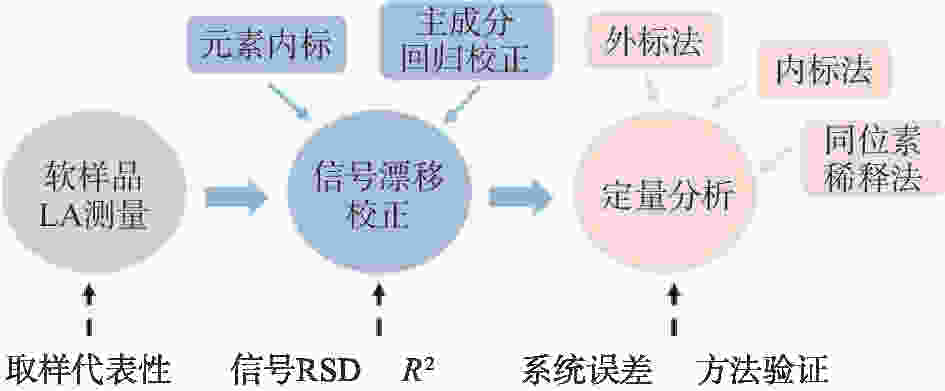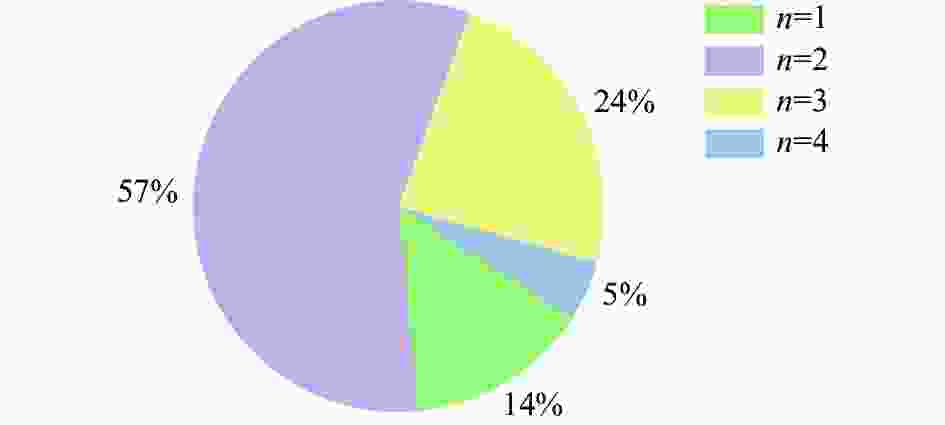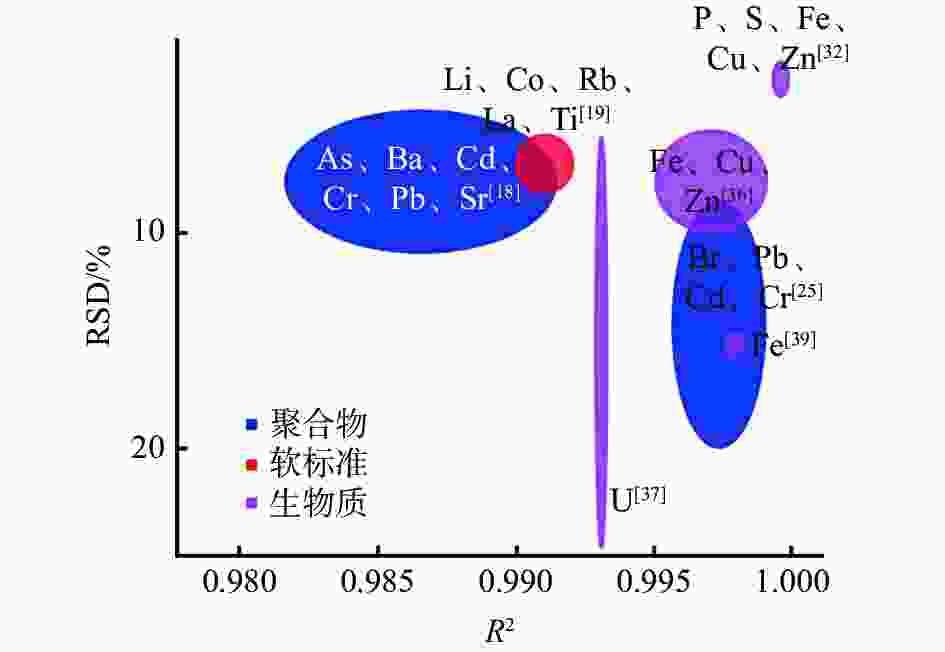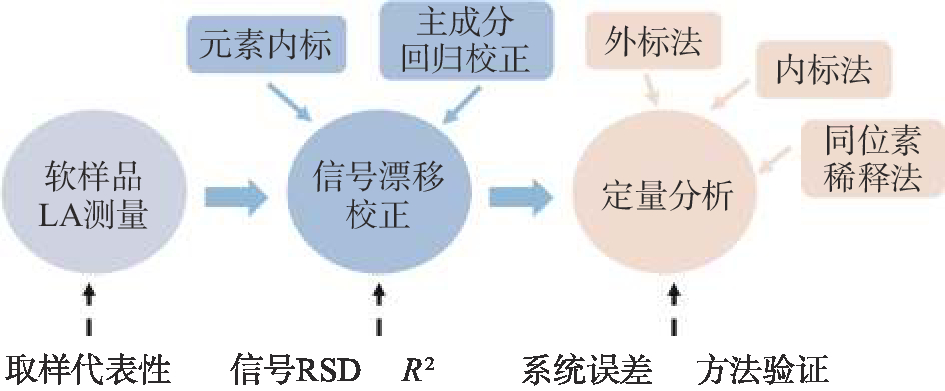Research Progress in Quantitative Analysis of Soft Samples Based on LA-ICP-MS
-
摘要: 激光剥蚀电感耦合等离子体质谱法(LA-ICP-MS)在近年来引起诸多关注,因为其能在准无损的条件下直接对固体样品分析,并且获得一定空间分辨率的原位元素浓度信息。然而由于元素分馏以及复杂的基质效应,LA-ICP-MS对于软质样品的定量分析仍具有挑战性。如要获得可靠可比的结果,相应的测量方案不仅需要使用经过验证的方法,还应建立基于标准物质的正确校正方法,从而实现测量结果的溯源性。本文通过分析2000年以来国内外研究团队发表的相关文献,介绍了LA-ICP-MS在三类不同软质样品测量中的常见测量策略,在此基础上通过汇总五个方面验证参数的情况,从方法精度、准确度、代表性三方面分析了定量方法的现状,并说明方法溯源性方面存在的问题。结果显示,基质匹配且同步测量的定量策略更有优势,另外受制于缺少完全基质匹配的CRM,领域内对于取样代表性及测量结果溯源性的研究并不充分。因此这两方面的相关内容,将会是未来利用LA-ICP-MS开展软质样品定量分析方法研究时需要重点解决的问题。国内在软质标准物质的合成方法和利用同位素稀释法实现测量结果溯源性等方面开展了一些研究,但依然有一系列问题尚待解决。Abstract: Laser ablation inductively coupled plasma mass spectrometry (LA-ICP-MS) has gained significant attention in recent years due to its capability to directly analyze solid samples under quasi-nondestructive conditions, and to provide in-situ elemental concentration information with a certain spatial resolution. However, quantitative analysis of soft samples by LA-ICP-MS remains a challenge due to elemental fractionation and complex matrix effects. To obtain reliable and comparable results, the corresponding measurement protocol not only requires the use of verified methods, but also the establishment of correct calibration methods based on standards, thus enabling the traceability of measurement results. This paper reviews relevant literature published by domestic and foreign research teams since 2000, and introduces the common measurement strategies of LA-ICP-MS for three different types of soft samples. By summarizing the verification parameters of the five methods, the current situation of quantitative methods is analyzed from three aspects: method precision, accuracy, and representativeness. The paper also highlights the problem of method traceability. The results show that the quantification strategy that matches the matrix and is synchronized with the measurement is more advantageous. However, the lack of a fully matrix-matched certified reference material (CRM) limits the research on sampling representativeness and traceability of measurement results. Therefore, these two aspects will be the key problems to be addressed in the future when using LA-ICP-MS to carry out quantitative analysis methods of soft samples. Although some researchers have conducted studies on the synthesis method of soft standard and the traceability of measurement results by isotope dilution method, there are still several issues that need to be resolved.
-
Key words:
- soft sample /
- LA-ICP-MS /
- calibration strategy /
- measurement /
- method verification /
- traceability
-
图 4 具有SI溯源性新方法原理示意图[62]
Figure 4. Schematic diagram of the new method with traceability to the International System of Units (SI)
表 1 三类软质样品的定量分析方法研究
Table 1. Research on quantitative analysis methods of three types of soft samples
序号 标准物质及样品a 关注元素b 仪器c 定量分析要素d 溯源性e 校正方法 引文 1 1.BCRCRM680
聚烯烃薄膜Ti、Cr、Cu、Br、Sr、Cd、Ba、Pb
(C)LA-ICP-QMS(Thermo Elemental Plasma Quad 3&New Wave Research LUV, 266 nm) 4.最小取样量mmin,5%=50 µg ~ 20 mg
5.XRF1.样品为CRM 内标及分馏系数归一化 [23] 2 1.聚碳酸酯、
聚乙烯Pb、Cd、Hg
(C)LA-ICP-QMS(Perkin-Elmer ELAN 6000 ICP-MS &Microprobe laser ablation unit, 266 nm) 4.最小取样量mmin,5%=4 ~
4000 mg
5.XRF归一化至C内标 [24] 3 1.BAM-010H Br、Pb、Cd、Cr
(C)LA-ICP-QMS(PerkinElmer Elan DRCII&Cetac-LSX213, 213 nm) 1. R2=0.9954 ~ 0.9995
2.RSD=8.9% ~ 20.3%1.样品为CRM 归一化至C内标 [25] 4 1.EC681k、
聚合物废料Al、Si、Ca、Ti、Fe、Ba、As、Cd、Sb、Hg、Pb
(Zn)LA-ICP-QMS(Agilent 7500cs &Lambda Physics Compex, 193 nm) 2. RSD>20%
3.差异值平均为53%
5.XRF、湿化学法1.NIST610、ERM681k外标 归一化至Zn内标 [7] 5 1.聚乙烯、聚丙烯、聚甲基丙烯
酸酯
ERM680k、681kAs、Ba、Cd、Cr、Pb、Sr、Zn
(C)LA-ICP-QMS(Perkin Elmer ELAN DRC II & Cetac LSX-266, 266 nm) 1.R2=0.982 ~ 0.991(除Zn)
2.RSD=5% ~ 10%(Cr、Sr、Pb在1 μg∙g-1级)
5.湿化学法1.ERM680k、681k方法验证 归一化至C内标、
干液滴外标[15] 6 1.聚丙烯、聚乙烯
BCRCRM680、680kAl、Ca、Mg、Ti、Zn、Si、As、Br、Cd、Cr、Hg、Pb、Sb
(Sc、Y)LA-ICP-QMS(7700X Agilent ICP-MS&Cetac LSX-213 G2+, 213 nm) 2.RSD=2.9% ~ 10.4%
5.湿化学法1.ERM680k、681k方法验证 归一化至(Sc、Y) [26] 7 1&2.聚甲基丙烯酸酯、聚酰亚胺、聚乙烯吡咯烷酮 Co、In、Pt LA-ICP-QMS/LIBS(ThermoFisher Scientific iCAP& Applied Spectra J200, 266 nm) 2.通常RSD=5%
3.平均偏差4.4%— 主成分回归校正 [27] 8 1.聚乙烯、聚丙烯、ABS、聚氯乙烯、聚酯 Br、Pb、Cd、Cr、Hg
(C)fsLA-ICP-MS
(7700X Agilent ICP-MS&Fab Instruments N-Stage, 266 nm)2.RSD=1.5% ~ 30%
3.偏差在30%以内1.样品为CRM 内标校正 [28] 9 2.共混聚合物薄膜 Fe、Zn、Rb、Y、Au
(C、Co、Cu)LA-ICP-QMS
(7500cs Agilent ICP-MS&Kenelec Technologies New Wave UP213, 213 nm)2.RSD=0.84% ~ 4.30%
3.偏差-30% ~ +25%— 内标校正 [20] 10 1.BAM-H010
2.共混聚合物薄膜Pb
(Bi)LA-ICP-QMS
(XSERIES 2 Thermo Scientific ICP-MS&Kenelec Technologies New Wave UP213, 213 nm)2.线间RSD<3%
3.量值一致1.BAM-H010方法验证
2.同位素稀
释法内标校正 [29] 11 2.明胶 As、Gd LA-ICP-QMS
(7900X Agilent ICP-MS &Teledyne Analyte G2, 193 nm)4.5 μm光斑下RSD<2.2% — [30] 12 2.琼脂糖 B、Na、Mg、P、S、K、Ca、Cr、Mn、Fe、Ni、Cu、Zn、As、Rb、Sr、Cd、Ba、Pb
(C)LA-ICP-QMS
(7700X Agilent ICP-MS&Coherent GeoLas ,
193 nm)1.R2>0.991
2.RSD<10%
3.平均相对误差小于10%1.CRM方法
验证内标校正 [31] 13 2.聚甲基丙烯酸
2-羟乙酯薄片、
载玻片Li、Co、Rb、La、Tl LA-ICP-QMS
(7700X Agilent ICP-MS&ESI NWR193, 193 nm ArF)1.R2>0.99
2.RSD=5.5% ~ 8.1%
3.偏差小于3.8%
5.湿化学法— 干液滴外标 [16] 14 3.大脑切片 P、S、Fe、Cu、Zn
(U、Th)LA-HR-ICP-MS
(ELEMENT Thermo HR-ICP-MS&(未注明厂家Nd:YAG 213 nm))1.R2=0.9995
2.RSD=2% ~ 3%
3.准确度2% ~ 3%— 内标校正、匀浆添加
外标[32] 15 3.大脑切片 Zn、Cu、Pb LA-HR-ICP-MS
(ELEMENT Thermo HR-ICP-MS&CETAC LSX 200, 266 nm)1.R2>0.994 — 匀浆添加
外标[33] 16 3.大脑切片 P、Fe
(C)LA-ICP-QMS
(8800Agilent ICP-MS&NewWave NWR213, 213 nm)1.R2=0.9849(Fe) — 内标校正、匀浆添加
外标[34] 17 3.大鼠肝脏 Fe、Cu LA-ICP-QMS
(iCAP Qc Thermo ICP-MS&CETAC LSX-213 G2+, 213 nm)1.R2>0.995
2.RSD<7.1%— 明胶外标 [35] 18 3.肝脏 Fe、Cu、Zn LA-ICP-QMS
(iCAP Qc Thermo ICP-MS&CETAC LSX-213 G2+, 213 nm)1.R2=0.995-0.999
2.RSD=5.1%-9.8%— 明胶外标 [36] 19 3.大鼠肾脏 U LA-ICP-QMS
(iCAP Q Thermo ICP-MS&CETAC Analyte Excite, 193 nm)1.R2=0.993
2.RSD=5% ~ 25%
5.溶液同位素稀释法2.溶液法通过同位素稀释溯源至SI 明胶内标、匀浆外标 [37] 20 3.小鼠脑 Fe、Cu、Zn
(C)LA-ICP-QMS
(7700X Agilent ICP-MS &CETAC LSX-213, 213 nm)2.RSD<8.9%
5.μ-XRF、ID-MS2.稀释法溯源至SI 归一化至C、液滴ID [38] 21 3.羊脑 Fe
(Rh)LA-HR-ICP-MS
(ELEMENT 2 Thermo HR-ICP-MS&(ESI NWR213, 213 nm))1. R2=0.9978
2.RSD=15%2.在线加标稀释法溯源至SI 归一化至Rh、在线双稀释 [39] 注:a:1代表传统聚合物;2代表人工合成的软质标准物质;3代表生物软质样品。b: 括号内为内标。c: 括号内为仪器型号。d: 包括1.线性相关系数R2;2.相对标准偏差RSD;3.系统误差;4.取样代表性;5.方法验证。e:“-”为文章中缺失内容。 -
[1] Hattendorf B, Latkoczy C, D Günther. Peer Reviewed: Laser Ablation-ICPMS[J]. Analytical Chemistry, 2003, 75(15): 341A-347A. doi: 10.1021/ac031283r [2] MARTINEZ M, BAUDELET M. Calibration strategies for elemental analysis of biological samples by LA-ICP-MS and LIBS – A review[J]. Anal Bioanal Chem, 2020, 412(1): 27-36. doi: 10.1007/s00216-019-02195-1 [3] RUSSO R E, MAO X, LIU H, et al. Laser ablation in analytical chemistry—a review[J]. Talanta, 2002, 57(3): 425-451. doi: 10.1016/S0039-9140(02)00053-X [4] FERNáNDEZ B, CLAVERIE F, PéCHEYRAN C, et al. Direct analysis of solid samples by fs-LA-ICP-MS[J]. Trends Anal Chem, 2007, 26(10): 951-966. doi: 10.1016/j.trac.2007.08.008 [5] GüNTHER D, HEINRICH C A. Comparison of the ablation behaviour of 266 nm Nd: YAG and 193 nm ArF excimer lasers for LA-ICP-MS analysis[J]. J Anal At Spectrom, 1999, 14(9): 1369-1374. doi: 10.1039/A901649J [6] PISONERO J, GüNTHER D. Femtosecond laser ablation inductively coupled plasma mass spectrometry: Fundamentals and capabilities for depth profiling analysis[J]. Mass Spectrom Rev, 2008, 27(6): 609-623. doi: 10.1002/mas.20180 [7] STEHRER T, HEITZ J, PEDARNIG J D, et al. LA-ICP-MS analysis of waste polymer materials[J]. Anal Bioanal Chem, 2010, 398(1): 415-424. doi: 10.1007/s00216-010-3963-6 [8] SAJNóG A, HANĆ A, BARAŁKIEWICZ D. Metrological approach to quantitative analysis of clinical samples by LA-ICP-MS: A critical review of recent studies[J]. Talanta, 2018, 182: 92-110. doi: 10.1016/j.talanta.2018.01.050 [9] MILISZKIEWICZ N, WALAS S, TOBIASZ A. Current approaches to calibration of LA-ICP-MS analysis[J]. J Anal At Spectrom, 2015, 30(2): 327-338. doi: 10.1039/C4JA00325J [10] TODOLı́ J L, MERMET J M. Study of polymer ablation products obtained by ultraviolet laser ablation — inductively coupled plasma atomic emission spectrometry[J]. Spectrochimica Acta Part B:Atomic Spectroscopy, 1998, 53(12): 1645-1656. doi: 10.1016/S0584-8547(98)00219-5 [11] FRICK D A, GüNTHER D. Fundamental studies on the ablation behaviour of carbon in LA-ICP-MS with respect to the suitability as internal standard[J]. J Anal At Spectrom, 2012, 27(8): 1294-1303. doi: 10.1039/c2ja30072a [12] WU B, ZORIY M, CHEN Y, et al. Imaging of nutrient elements in the leaves of Elsholtzia splendens by laser ablation inductively coupled plasma mass spectrometry (LA-ICP-MS)[J]. Talanta, 2009, 78(1): 132-137. doi: 10.1016/j.talanta.2008.10.061 [13] SYLVESTER P J. LA-(MC)-ICP-MS Trends in 2006 and 2007 with Particular Emphasis on Measurement Uncertainties[J]. Geostand Geoanal Res, 2008, 32(4): 469-488. doi: 10.1111/j.1751-908X.2008.00924.x [14] TAYLOR A, DAY M P, HILL S, et al. Atomic spectrometry update: Review of advances in the analysis of clinical and biological materials, foods and beverages[J]. J Anal At Spectrom, 2014, 29(3): 386-426. doi: 10.1039/c4ja90001d [15] VOSS M, NUNES M A G, CORAZZA G, et al. A new approach to calibration and determination of selected trace elements in food contact polymers by LA-ICP-MS[J]. Talanta, 2017, 170: 488-495. doi: 10.1016/j.talanta.2017.04.048 [16] KUCZELINIS F, PETERSEN J H, WEIS P, et al. Calibration of LA-ICP-MS via standard addition using dried picoliter droplets[J]. J Anal At Spectrom, 2020, 35(9): 1922-1931. doi: 10.1039/D0JA00184H [17] REIFSCHNEIDER O, SCHüTZ C L, BROCHHAUSEN C, et al. Quantitative bioimaging of p-boronophenylalanine in thin liver tissue sections as a tool for treatment planning in boron neutron capture therapy[J]. Anal Bioanal Chem, 2015, 407(9): 2365-2371. doi: 10.1007/s00216-014-8012-4 [18] POZEBON D, DRESSLER V L, MESKO M F, et al. Bioimaging of metals in thin mouse brain section by laser ablation inductively coupled plasma mass spectrometry: novel online quantification strategy using aqueous standards[J]. J Anal At Spectrom, 2010, 25(11): 1739-1744. doi: 10.1039/c0ja00055h [19] 刘勇胜, 胡兆初, 李明, 等. LA-ICP-MS在地质样品元素分析中的应用[J]. Chin Sci Bull, 2013, 58(36): 3753-3769. [20] AUSTIN C, FRYER F, LEAR J, et al. Factors affecting internal standard selection for quantitative elemental bio-imaging of soft tissues by LA-ICP-MS[J]. J Anal At Spectrom, 2011, 26(7): 1494-1501. doi: 10.1039/c0ja00267d [21] PAN H, FENG L, LU Y, et al. Calibration strategies for laser ablation ICP-MS in biological studies: A review[J]. Trends Anal Chem, 2022, 156: 116710. doi: 10.1016/j.trac.2022.116710 [22] BEDSON P. Guidelines for achieving high accuracy in isotope dilution mass spectrometry (IDMS) [M]. Royal Society of Chemistry, 2002. [23] KEMPENAERS L, BINGS N H, JEFFRIES T E, et al. The use of LA-ICP-MS for the characterization of the micro-heterogeneity of heavy metals in BCR CRM 680[J]. J Anal At Spectrom, 2001, 16(9): 1006-1011. doi: 10.1039/b102512k [24] DOBNEY A M, MANK A J G, GROBECKER K H, et al. Laser ablation inductively coupled plasma mass spectrometry as a tool for studying heterogeneity within polymers[J]. Anal Chim Acta, 2000, 423(1): 9-19. doi: 10.1016/S0003-2670(00)01047-3 [25] MANS C, SIMONS C, HANNING S, et al. New polymeric candidate reference materials for XRF and LA-ICP-MS - development and preliminary characterization[J]. X-Ray Spectrom, 2009, 38(1): 52-57. doi: 10.1002/xrs.1120 [26] VILLASEñOR Á, BOCCONGELLI M, TODOLí J L. Quantitative elemental analysis of polymers through laser ablation – inductively coupled plasma by using a dried droplet calibration approach, DDCA[J]. J Anal At Spectrom, 2018, 33(7): 1173-1183. doi: 10.1039/C8JA00055G [27] BONTA M, LIMBECK A. Metal analysis in polymers using tandem LA-ICP-MS/LIBS: eliminating matrix effects using multivariate calibration[J]. J Anal At Spectrom, 2018, 33(10): 1631-1637. doi: 10.1039/C8JA00161H [28] MAKINO Y, NAKAZATO T. Determination of trace elements in polymers using fsLA-ICP-MS with internal standardization by carbon[J]. J Anal At Spectrom, 2021, 36(9): 1895-1899. doi: 10.1039/D1JA00198A [29] THIELEKE J P, VOGT C. A calibration strategy for LA-ICP-MS using isotope dilution for solid reference materials[J]. J Anal At Spectrom, 2016, 31(6): 1198-1205. doi: 10.1039/C6JA00042H [30] ŠALA M, ŠELIH V S, VAN ELTEREN J T. Gelatin gels as multi-element calibration standards in LA-ICP-MS bioimaging: fabrication of homogeneous standards and microhomogeneity testing[J]. Analyst, 2017, 142(18): 3356-3359. doi: 10.1039/C7AN01361B [31] LI Y, GUO W, HU Z, et al. Method Development for Direct Multielement Quantification by LA-ICP-MS in Food Samples[J]. Journal of Agricultural and Food Chemistry, 2019, 67(3): 935-942. doi: 10.1021/acs.jafc.8b05479 [32] BECKER J S, ZORIY M V, PICKHARDT C, et al. Imaging of Copper, Zinc, and Other Elements in Thin Section of Human Brain Samples (Hippocampus) by Laser Ablation Inductively Coupled Plasma Mass Spectrometry[J]. Anal Chem, 2005, 77(10): 3208-3216. doi: 10.1021/ac040184q [33] DOBROWOLSKA J, DEHNHARDT M, MATUSCH A, et al. Quantitative imaging of zinc, copper and lead in three distinct regions of the human brain by laser ablation inductively coupled plasma mass spectrometry[J]. Talanta, 2008, 74(4): 717-723. doi: 10.1016/j.talanta.2007.06.051 [34] HARE D J, RAVEN E P, ROBERTS B R, et al. Laser ablation-inductively coupled plasma-mass spectrometry imaging of white and gray matter iron distribution in Alzheimer's disease frontal cortex[J]. NeuroImage, 2016, 137: 124-131. doi: 10.1016/j.neuroimage.2016.05.057 [35] HACHMöLLER O, AICHLER M, SCHWAMBORN K, et al. Element bioimaging of liver needle biopsy specimens from patients with Wilson’s disease by laser ablation-inductively coupled plasma-mass spectrometry[J]. J Trace Elem Med Biol, 2016, 35: 97-102. doi: 10.1016/j.jtemb.2016.02.001 [36] HACHMöLLER O, ZIBERT A, ZISCHKA H, et al. Spatial investigation of the elemental distribution in Wilson’s disease liver after d-penicillamine treatment by LA-ICP-MS[J]. J Trace Elem Med Biol, 2017, 44: 26-31. doi: 10.1016/j.jtemb.2017.05.008 [37] GRIJALBA N, LEGRAND A, HOLLER V, et al. A novel calibration strategy based on internal standard–spiked gelatine for quantitative bio-imaging by LA-ICP-MS: application to renal localization and quantification of uranium[J]. Anal Bioanal Chem, 2020, 412(13): 3113-3122. doi: 10.1007/s00216-020-02561-4 [38] FENG L, WANG J, LI H, et al. A novel absolute quantitative imaging strategy of iron, copper and zinc in brain tissues by Isotope Dilution Laser Ablation ICP-MS[J]. Anal Chim Acta, 2017, 984: 66-75. doi: 10.1016/j.aca.2017.07.003 [39] DOUGLAS D N, O'REILLY J, O'CONNOR C, et al. Quantitation of the Fe spatial distribution in biological tissue by online double isotope dilution analysis with LA-ICP-MS: a strategy for estimating measurement uncertainty[J]. J Anal At Spectrom, 2016, 31(1): 270-279. doi: 10.1039/C5JA00351B [40] WIENOLD J, RECKNAGEL S, SCHARF H, et al. Elemental analysis of printed circuit boards considering the ROHS regulations[J]. Waste Management, 2011, 31(3): 530-535. doi: 10.1016/j.wasman.2010.10.002 [41] SIMONS C, MANS C, HANNING S, et al. Study on microscopic homogeneity of polymeric candidate reference materials BAM H001-BAM H010 by means of synchrotron mu-XRF and LA-ICP-MS[J]. J Anal At Spectrom, 2010, 25(1): 40-43. doi: 10.1039/B917008A [42] ZHOU J, NI X, FU J, et al. Quantitation and ImagingAnalysis of Biological Samples by LA-ICP-MS[J]. At Spectrosc, 2021, 42(4): 210-216. [43] VAN HELDEN T, BRAEUER S, VAN ACKER T, et al. High-speed mapping of Hg and Se in biological tissue via laser ablation-inductively coupled plasma-mass spectrometry[J]. J Anal At Spectrom, 2022, 37(7): 1455-1461. doi: 10.1039/D2JA00131D [44] ZHOU J, GUO W, JIN L, et al. Elemental Analysis of Solid Food Materials Using a Reliable LaserAblation Inductively Coupled Plasma Mass Spectrometry Method[J]. Journal of Agricultural and Food Chemistry, 2022, 70(15): 4765-4773. doi: 10.1021/acs.jafc.1c06262 [45] DEEGAN R D, BAKAJIN O, DUPONT T F, et al. Capillary flow as the cause of ring stains from dried liquid drops[J]. Nature, 1997, 389(6653): 827-829. doi: 10.1038/39827 [46] HU H, LARSON R G. Marangoni effect reverses coffee-ring depositions[J]. J Phys Chem B, 2006, 110(14): 7090-7094. doi: 10.1021/jp0609232 [47] ZORIY M V, BECKER J S. Imaging of elements in thin cross sections of human brain samples by LA-ICP-MS: A study on reproducibility[J]. Int J Mass spectrom, 2007, 264(2): 175-180. [48] COSTAS-RODRíGUEZ M, VAN ACKER T, HASTUTI A A M B, et al. Laser ablation-inductively coupled plasma-mass spectrometry for quantitative mapping of the copper distribution in liver tissue sections from mice with liver disease induced by common bile duct ligation[J]. J Anal At Spectrom, 2017, 32(9): 1805-1812. doi: 10.1039/C7JA00134G [49] NEUMANN B, HöSL S, SCHWAB K, et al. Multiplex LA-ICP-MS bio-imaging of brain tissue of a parkinsonian mouse model stained with metal-coded affinity-tagged antibodies and coated with indium-spiked commercial inks as internal standards[J]. J Neurosci Methods, 2020, 334: 108591. doi: 10.1016/j.jneumeth.2020.108591 [50] WESTERHAUSEN M T, LOCKWOOD T E, GONZALEZ DE VEGA R, et al. Low background mould-prepared gelatine standards for reproducible quantification in elemental bio-imaging[J]. Analyst, 2019, 144(23): 6881-6888. doi: 10.1039/C9AN01580A [51] ZHENG L N, FENG L X, SHI J W, et al. Single-Cell Isotope Dilution Analysis with LA–ICP–MS: A New Approach for Quantification of Nanoparticles in Single Cells[J]. Anal Chem, 2020, 92(21): 14339-14345. doi: 10.1021/acs.analchem.0c01775 [52] MARTINEZ-LOPEZ C, TREJOS T, COULSON S, et al. Interlaboratory evaluations of the performance of elemental analytical methods for the forensic analysis and comparisons of electrical tapes[J]. Forensic Chemistry, 2019, 12: 66-77. doi: 10.1016/j.forc.2019.01.001 [53] MARTINEZ-LOPEZ C, SAKAYANAGI M, ALMIRALL J R. Elemental analysis of packaging tapes by LA-ICP-MS and LIBS[J]. Forensic Chemistry, 2018, 8: 40-48. doi: 10.1016/j.forc.2018.01.004 [54] VANDER PYL C, MARTINEZ-LOPEZ C, MENKING HOGGATT K, et al. Analysis of primer gunshot residue particles by laser induced breakdown spectroscopy and laser ablation inductively coupled plasma mass spectrometry[J]. Analyst, 2021, 146(17): 5389-5402. doi: 10.1039/D1AN00689D [55] THOMPSON M, ELLISON S L, WOOD R. Harmonized guidelines for single-laboratory validation of methods of analysis (IUPAC Technical Report)[J]. Pure Appl Chem, 2002, 74(5): 835-855. doi: 10.1351/pac200274050835 [56] JUROWSKI K, BUSZEWSKI B, PIEKOSZEWSKI W. The analytical calibration in (bio)imaging/mapping of the metallic elements in biological samples – Definitions, nomenclature and strategies: State of the art[J]. Talanta, 2015, 131: 273-285. doi: 10.1016/j.talanta.2014.07.089 [57] PISONERO J, FERNáNDEZ B, GüNTHER D. Critical revision of GD-MS, LA-ICP-MS and SIMS as inorganic mass spectrometric techniques for direct solid analysis[J]. J Anal At Spectrom, 2009, 24(9): 1145-1160. doi: 10.1039/b904698d [58] CARTER S, FISHER A, GARCIA R, et al. Atomic spectrometry update: review of advances in the analysis of metals, chemicals and functional materials[J]. J Anal At Spectrom, 2016, 31(11): 2114-2164. doi: 10.1039/C6JA90044E [59] LOBO L, FERNáNDEZ B, MUñIZ R, et al. Capabilities of radiofrequency pulsed glow discharge-time of flight mass spectrometry for molecular screening in polymeric materials: positive versus negative ion mode[J]. J Anal At Spectrom, 2016, 31(1): 212-219. doi: 10.1039/C5JA00291E [60] JERŠE A, MERVIČ K, VAN ELTEREN J T, et al. Quantification anomalies in single pulse LA-ICP-MS analysis associated with laser fluence and beam size[J]. Analyst, 2022, 147(23): 5293-5299. doi: 10.1039/D2AN01172G [61] VAN ELTEREN J T, ŠELIH V S, ŠALA M. Insights into the selection of 2D LA-ICP-MS (multi)elemental mapping conditions[J]. J Anal At Spectrom, 2019, 34(9): 1919-1931. doi: 10.1039/C9JA00166B [62] MICHALISZYN L, REN T, RöTHKE A, et al. A new method for the SI-traceable quantification of element contents in solid samples using LA-ICP-MS[J]. J Anal At Spectrom, 2020, 35(1): 126-135. doi: 10.1039/C9JA00296K [63] 吴雪, 薄梦, 孙晓璟, 等. 液相色谱-质谱法检测甲磺酸沙非胺中基因毒性杂质[J]. 计量科学与技术, 2022, 66(11): 27-30. [64] 易可可, 谢洁, 龚晓云, 等. 液相色谱-串联质谱应用研究进展[J]. 计量科学与技术, 2021(2): 7-15, 6. -


 作者投稿
作者投稿 专家审稿
专家审稿 编辑办公
编辑办公


 下载:
下载:






